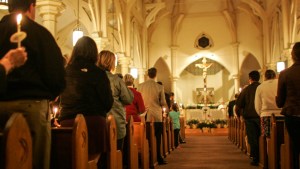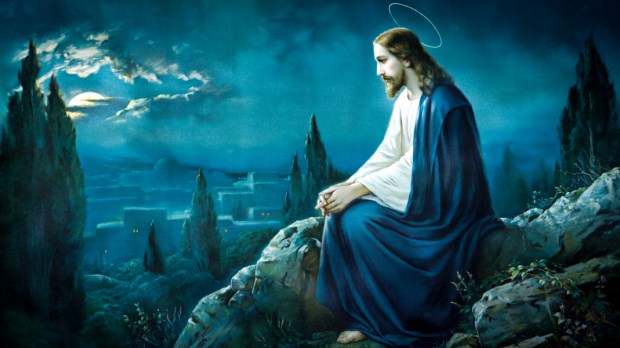On Thursday of Holy Week the Church remembers Christ’s Last Supper with his apostles and sets the scene for what will happen the next day. During the the celebration of the Lord’s Supper, the liturgy re-enacts in a solemn way the movement of Jesus to the Garden of Gethsemane.

Read more:
Here’s a step-by-step guide to the Easter Vigil
After the distribution of Holy Communion the priest does not place the remaining hosts in the primary tabernacle where the Blessed Sacrament is usually reserved. Instead he places them on the altar.
The Roman Missal then continues the description of what happens next.
A procession is formed in which the Blessed Sacrament, accompanied by torches and incense, is carried through the church to a place of repose prepared in a part of the church or in a chapel suitably decorated…When the procession reaches the place of repose, the Priest, with the help of the Deacon if necessary, places the ciborium in the tabernacle, the door of which remains open. Then he puts incense in the thurible and, kneeling, incenses the Blessed Sacrament, while Tantum ergo Sacramentum or another Eucharistic chant is sung. Then the Deacon or the Priest himself places the Sacrament in the tabernacle and closes the door.
The Garden of Gethsemane
Often the Eucharist is placed in a secondary tabernacle on a side altar, or in an area of the church that is most suitable. This procession from the main altar to another location in the church is symbolic of the movement of Jesus to the Garden of Gethsemane, where he experiences great agony before his arrest and betrayal.
The Roman Missal explains what should take place after placing the Eucharist in this new location.
The faithful are invited to continue adoration before the Blessed Sacrament for a suitable length of time during the night, according to local circumstances, but after midnight the adoration should take place without solemnity.
This tradition of adoring Our Lord in the Blessed Sacrament on Holy Thursday is often called the “Night Watch” or “Gethsemane Watch” and recalls how Jesus invited his apostles to stay with him while he prayed.
And he said to them, “My soul is very sorrowful, even to death; remain here, and watch.”
Mark 14:34
It is a beautiful custom, one where it is possible to feel an added weight in the air. In essence the faithful are asked to accompany Jesus to the Garden and console him during his great agony. All one needs for prayer on this sacred night is to simply imagine the scene and enter into the sacred night before Jesus’ death on the cross. It is extremely powerful to imagine being there with Jesus in the Garden, watching the sweat of blood drip down his face as he prepares to sacrifice himself for our sins.
Typically parishes try to sign up individuals or families to watch with Our Lord until midnight. In a certain sense Jesus challenges all of us to keep watch with him for at least one hour on Holy Thursday, as he challenged his apostles on that fateful night.
And he came and found them sleeping, and he said to Peter, “Simon, are you asleep? Could you not watch one hour?”
Mark 14: 37
It is a challenge that comes straight from Jesus and is a powerful way to begin the remembrance of the Paschal Mystery of our salvation. Will we take up the challenge of Our Lord?

